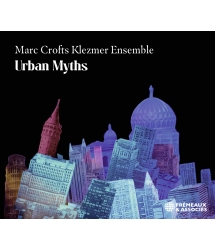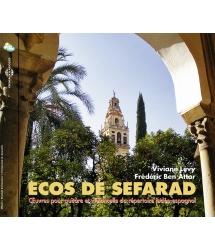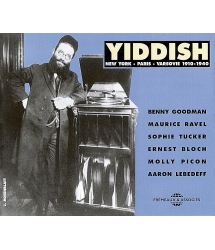- Our Catalog
- Philosophy
- Philosophers of the 20th century and today
- History of Philosophy (PUF)
- Counter-History and Brief Encyclopedia by Michel Onfray
- The philosophical work explained by Luc Ferry
- Ancient thought
- Thinkers of yesterday as seen by the philosophers of today
- Historical philosophical texts interpreted by great actors
- History
- Books (in French)
- Social science
- Historical words
- Audiobooks & Literature
- Our Catalog
- Jazz
- Blues
- Rock - Country - Cajun
- French song
- World music
- Africa
- France
- Québec / Canada
- Hawaï
- West Indies
- Caribbean
- Cuba & Afro-cubain
- Mexico
- South America
- Tango
- Brazil
- Tzigane / Gypsy
- Fado / Portugal
- Flamenco / Spain
- Yiddish / Israel
- China
- Tibet / Nepal
- Asia
- Indian Ocean / Madagascar
- Japan
- Indonesia
- Oceania
- India
- Bangladesh
- USSR / Communist songs
- World music / Miscellaneous
- Classical music
- Composers - Movie Soundtracks
- Sounds of nature
- Our Catalog
- Youth
- Philosophy
- News
- How to order ?
- Receive the catalog
- Manifesto
- Dictionnary











- Our Catalog
- Philosophy
- Philosophers of the 20th century and today
- History of Philosophy (PUF)
- Counter-History and Brief Encyclopedia by Michel Onfray
- The philosophical work explained by Luc Ferry
- Ancient thought
- Thinkers of yesterday as seen by the philosophers of today
- Historical philosophical texts interpreted by great actors
- History
- Books (in French)
- Social science
- Historical words
- Audiobooks & Literature
- Our Catalog
- Jazz
- Blues
- Rock - Country - Cajun
- French song
- World music
- Africa
- France
- Québec / Canada
- Hawaï
- West Indies
- Caribbean
- Cuba & Afro-cubain
- Mexico
- South America
- Tango
- Brazil
- Tzigane / Gypsy
- Fado / Portugal
- Flamenco / Spain
- Yiddish / Israel
- China
- Tibet / Nepal
- Asia
- Indian Ocean / Madagascar
- Japan
- Indonesia
- Oceania
- India
- Bangladesh
- USSR / Communist songs
- World music / Miscellaneous
- Classical music
- Composers - Movie Soundtracks
- Sounds of nature
- Our Catalog
- Youth
- Philosophy
- News
- How to order ?
- Receive the catalog
- Manifesto
- Dictionnary
DEBEN BHATTACHARYA COLLECTION 1948-1998
Ref.: FA079
EAN : 3448960207928
Artistic Direction : DEBEN BHATTACHARYA
Label : Frémeaux & Associés
Total duration of the pack : 1 hours 53 minutes
Nbre. CD : 2
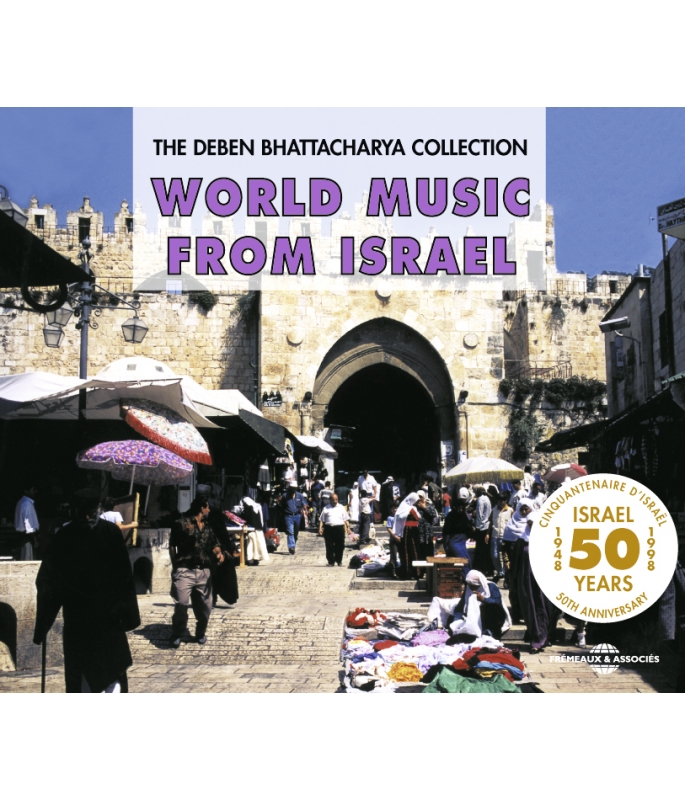
DEBEN BHATTACHARYA COLLECTION 1948-1998
DEBEN BHATTACHARYA COLLECTION 1948-1998
(2-CD set) Deben Bhattacharya celebrated the 50th anniversary of the Jewish State with recordings made in the first years of its etablishment. They recall a time when people with the same religion but from different cultural backgrounds were arriving from the world over. These CDs are a precious archive of the musical and cultural encounters of those early days. Includes a 48 page booklet with both French and English notes.
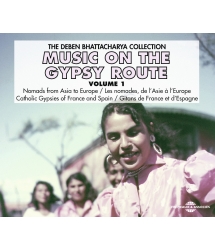
DEBEN BHATTACHARYA COLLECTION
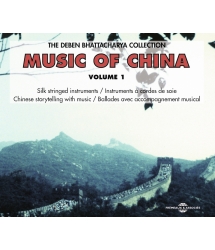
DEBEN BHATTACHARYA COLLECTION
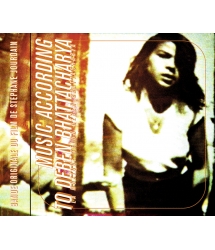
BANDE ORIGINALE DU FILM DE STÉPHANE JOURDAIN



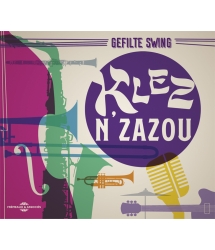

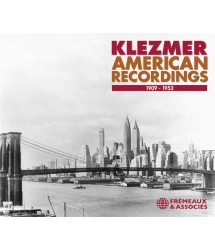
-
PisteTitleMain artistAutorDurationRegistered in
-
1LOVE SONG IN ARABICAQUE MALKA00:03:541957
-
2MAQAM SEEKAMAHMAN MEIR00:06:321957
-
3THE SWEETNESS OF THE EARTHYEHUDA SEBAG00:04:521957
-
4MAQAM AEIRAGYEHUDA SEBAG00:05:221957
-
5AL ZINYEHUDA SEBAG00:04:301957
-
6THE SEVILLIAN GIRLSEEKA MAQAM00:04:341957
-
7WEDDING SONGANONYME00:04:121957
-
8LOVE SONG IN ARABICYEHUDA SEBAG00:03:411957
-
9HEBREW WEDDING SONGANONYME00:04:581957
-
10PERSIAN LOVE SONGGROUPE DE MUSIQUE BOUKHARA00:04:121957
-
11DANCE MUSICGROUPE DE MUSIQUE BOUKHARA00:03:151957
-
12MISKIN MODEMENAHEM ELIEZACOFF00:03:381957
-
13BUKHARI RYTHMS ON DOIRASGROUPE DE MUSIQUE BOUKHARA00:02:241957
-
14SONG FOR HARVESTING FRUITSGROUPE DE MUSIQUE BOUKHARA00:03:101957
-
PisteTitleMain artistAutorDurationRegistered in
-
1MAY THE TEMPLE BE REBUILTISRAEL STERN00:08:211957
-
2SHEMA ISRAELISRAEL STERN00:05:241998
-
3GOOD ADVICEJOSEPH STERN00:04:461957
-
4ZAMO LECHO NAFSIRABBI LEVINSOHN00:06:091957
-
5ADDITIONAL PRAYER ON THE SABBATHMOSHE ANSHIN00:03:391957
-
6EAST EUROPEAN WEDDING DANCESTEL AVIV POLICE BAND00:04:231957
-
7JEWISH MELODIESTEL AVIV POLICE BAND00:04:271957
-
8THE MARKET SONGABRAHAM AVIGANIM00:06:561957
-
9THE PRISONER AND HIS BELOVEDABRAHAM AVIGANIM00:06:501957
-
10SILKEN HAIRANONYME00:03:241957
WORLD MUSIC FROM ISRAEL FA 079
WORLD MUSIC FROM ISRAEL
AVANT-PROPOS
J’ai eu le privilège d’aller en Israël en 1957 alors que des Juifs venus du monde entier arrivaient encore pour essayer de s’établir dans ce nouvel état qui avait tout juste dix ans d’existence. La première chose qui m’a frappé au moment de mon arrivée était l’extraordinaire diversité des visages et l’éblouissante variété des sons et des musiques. C’était littéralement comme un déversement de gens venus d’Est, d’Ouest, du Nord et du Sud, qui apportaient avec eux les habitudes, la langue et la musique de leur pays d’origine. La première impression était celle d’un mélange de l’ancien et du nouveau qui s’affrontaient, celle d’une tentative d’intégrer l’Occident à l’Orient, d’unir l’ancien et le sacré au scepticisme contemporain. En consultant aujourd’hui mes notes pour la rédaction de ce texte, j’ai retrouvé une liste de rendez-vous avec des musiciens venus d’à peu près tous les pays du monde : par exemple, du Maroc en Afrique du Nord ou du Yémen dans la péninsule Arabique, ou bien encore de Boukhara en Asie Centrale ou d’Espagne en Europe du Sud, toutes ces régions pouvant littéralement être décrites comme des mondes séparés. Ainsi, sur une petite parcelle de terre d’Asie Occidentale, Israël abritait l’ensemble du monde de la musique, l’expression contemporaine de «world music» ou «musiques du monde» n’étant pas d’usage à l’époque.Je suis revenu d’Israël avec de longues heures d’enregistrement et des centaines de photos que j’écoute ou regarde aujourd’hui encore avec affection et grand plaisir. Une petite partie de cette collection a été publiée en 1958 par les éditions Westminster, à New York, constituant une série de quatre albums 33 tours intitulée Israël Aujourd’hui.
Néanmoins cela fait vingt ans qu’ils sont épuisés et hors circulation. En plus des quatre albums, un livre de photos comportant un petit 45 tours intitulé Visages d’Israël fut publié par Seghers-B.A.M., à Paris en 1960. Cette édition aussi est épuisée depuis trente ans. Par conséquent, nous nous sommes décidés à publier cette nouvelle édition sur CD à l’occasion du 50ème anniversaire de la création de l’état d’Israël. Afin de donner une forme aux enregistrements présentés dans ces CDs, j’ai dû abandonner des séquences de mes propres pérégrinations en Israël. Etant donné l’extraordinaire variété d’éléments humains et musicaux qui prédominait à la fin des années 50, la seule manière dont je puisse présenter ces enregistrements est de me réfèrer au contexte géographique d’origine de chacun des artistes que vous allez entendre sur ces CDs. Comme vous le verrez sur la carte, les communautés représentées sur ces CDs sont indiquées par des flêches pointées en direction d’Israël. Leur dates d’arrivée varient beaucoup, de deux ou trois générations pour les unes, à une année précédant mes enregistrements de 1957. Le chanteur ukrainien Moshe Anshin, par exemple, (voir CD 2, morceau 5) est né à Jérusalem de parents qui avaient émigré d’Ukraine. En revanche, le fiancé tunisien dont vous entendrez une partie du mariage (CD 1, morceau 7) était arrivé seulement une année et demie avant que je ne le rejoigne pour la célébration de son mariage. Déjà en 1957 quand j’enregistrais, on percevait des signes de l’influence d’une musique sur l’autre. Certains de ces mélanges se faisaient spontanément et sans efforts, tandis que d’autres pourraient être décrits comme étant le résultat d’expériences délibérées.Ce coffret de deux CDs est une modeste tentative d’illustrer certains des éléments musicaux importants qui ont pénétré le pays, accompagnant le flot de migrants originaires du monde entier venus en Israël depuis qu’il ouvrit ses frontières aux Juifs de tous les continents.
DEBEN BHATTACHARYA
CD 1: LA MUSIQUE DES JUIFS D’ORIENT
LA MUSIQUE ET LES INSTRUMENTS
Les chansons et la musique instrumentale marocaines ne peuvent être ni classifiées comme musique floklorique d’un arrière-pays rural et peu sophistiqué, ni vraiment comme étant strictement une musique artistique destinée à des réjouissances populaires. Les chanteurs juifs marocains, dont la terre d’origine était l’Espagne mais qui ont par la suite migré vers le Maroc, étaient peu suceptibles d’oublier les influences mélodiques mauresques d’Andalousie, dont on dit qu’elles ont inspiré le chant Flamenco. Bien que les chansons juives marocaines soient chantées en Arabe, la mélodie et les paroles ont un caractère profondément nostalgique. On trouve par exemple ce genre de paroles : «Je me souviens d’une belle, avec une grain de beauté et de sombres yeux enchanteurs. Oh, cette fille de Séville m’a rendu fou... Elle était si belle!» Les chansons sont accompagnées par des instruments arabes classiques, comme le ’Ud, l’équivalent du luth mais qui a dix cordes réparties en cinq paires, et que l’on pince avec l’embout d’une plume; Le Qanun, un psaltérion à soixante dix-huit cordes réparties par trois et pincées avec une paire de plectres, et la Derbouka - percussion en forme de gobelet évasé et à une seule tête; enfin, un tambourin et un violon complètent l’ensemble.Les Juifs Yéménites viennent eux de l’état musulman du Yémen, situé au sud de la péninsule arabique.
Dans l’état Wahabitte d’Arabie Saoudite - le siège de l’Islam - la musique est un art proscrit, et par conséquent, au Yémen voisin, on lui porte également assez peu de considération. Les musiciens yéménites qui sont représentés sur le disque m’ont raconté qu’au Yémen, l’ethnie dominante avait refusé aux Juifs le droit de jouer quelque instrument que ce soit. D’où leur amour pour tous les instruments à percussion, qui s’est développé en pratiquant sur des assiettes de métal ou des boîtes de kérosène, faciles à se procurer.Le groupe de Boukhara représenté sur ce CD était peut être le seul groupe d’Asie Centrale important présent en Israël à l’époque où je réalisais ces enregistrements, en Juin-Juillet 1957. La plupart des musiciens gagnaient leur vie à partir de l’artisanat traditionnel qu’est la broderie et ne jouaient en public qu’occasionellement. Leurs instruments d’accompagnement étaient le Chang, la version la plus ancienne du Dulcimer iranien couramment en usage, appellé Santoor. Ce Chang avait une structure plate, sur laquelle étaient tendues quarante deux cordes, par séries de trois. Ils les pinçaient avec une paire de petits marteaux en bois légers. Parmi les autres instruments de l’ensemble, il y avait une viole de gambe, apellé le Kamancha, un instrument à trois cordes, que l’on pince, appelé le Tambur et une paire de percusions à cadre, les Doiras.
AFRIQUE DU NORD
1. CHANSON D’AMOUR EN ARABE - Chantée en Arabe par Sebag Yehuda qui joue le ’ûd lui-même. Il est accompagné à la derbouka par Aharon Abraham. Pour des informations sur les instruments, voir l’introduction ci-dessus. Enregistré à Jérusalem, Juin 1957. Durée : 3’45.
2. MAQAM SEEKA - Chantée en Arabe sur un mode classique, le Maqam Seeka est une chanson d’amour. La voix principale est celle de Mahman Meir qui chante avec Sebag Yehuda, Ohayon Masood, Aharon Abraham et Abraham El-Harar. Les chanteurs s’accompagnent du ’ûd, du qânûn, de la derbouka et du tambourin tandis que les auditeurs marocains frappent dans leurs mains. Pour plus d’information sur les instruments, voir l’introduction ci-dessus. Enregistré à Jérusalem, Juin 1957. Durée : 6’30.
3. LA DOUCEUR DE LA TERRE - Chantée par Sebag Yehuda qui s’accompagne du ’ûd, cette chanson commence avec les paroles suivantes : «La douceur de cette belle terre, jamais je ne l’oublierai». Chantée par Maqam Hijaz. Pour des informations sur le ’ûd, voir introduction ci-dessus. Enregistré à Jérusalem, Juin 1957. Durée : 4’5.
4. MAQAM AEIRAG - Une chanson d’amour dont les premières paroles sont: «Mon ami, où est-il?», chantée par Sebag Yehuda, comme ci-dessus, qui s’accompagne du ’ûd. Enregistré à Jérusalem, Juin 1957. Durée : 5’10.
5. ‘AL ZIN - Pour la beauté. Chanson d’amour algérienne, chantée par Sebag Yehuda, qui s’accompagne du ’ûd comme ci-dessus. Enregistré à Jérusalem, Juin 1957. Durée : 4’30.
6. LA FILLE DE SÉVILLE - «Je me souviens de cette belle, elle avait un grain de beauté et des yeux sombres et enchanteurs. Oh, cette fille de Séville, elle m’a rendu fou - elle était si belle». Chantée sur le mode Maqam Seeka, c’est une chanson d’amour marocaine en mémoire d’une belle de Séville. Elle est chantée par Sebag Yehuda qui s’accompagne au ’ûd. Enregistré à Jérusalem, Juin 1957. Durée : 4’25.
7. CHANSON DE MARIAGE - Chant et claquement des mains par une amie de la famille juive tunisienne du jeune marié. Comme c’est la coutume dans la communauté juive tunisienne, elle chante en Arabe, pour ouvrir la cérémonie et aussi pour le divertissement des jeunes mariés et de leurs invités. Enregistré à Safed, Juin 1957. Durée : 4’.
YEMEN
8. CHANSON D’AMOUR EN ARABE - Chantée par Malka Aque et Shalom Assair qui s’accompagnent d’une Derbouka et d’un bidon de kérosène métallique. Pour plus d’informations, voir l’introduction ci-dessus. Enregistré au campement yémenite de Yishi, au sud de Hartuv, Juin 1957. Durée : 3’30.
9. CHANSON DE MARIAGE EN HEBREU - chantée par un homme qui s’accompagne en frappant sur un bidon de kérosène métallique (voir introduction). Enregistré à Yishi, Juin 1957. Durée : 4’50.
BOUKHARA
10. CHANSON D’AMOUR PERSE - Chantée par une femme membre du Groupe Musical de Boukhara et accompagnée par le Chang, Kamancha, le Tambur, une flûte de fonte et une paire de percusssions à cadre appelées Doiras, jouées par d’autres membres du groupe sous la direction de Menhanen Eliezacoff. Pour plus d’information sur les instruments, voir l’introduction. Enregistré à Tel Aviv, Juillet 1957. Durée : 4’50.
11. MUSIQUE POUR DANSER - de Boukhara. Au début de l’enregistrement, les musiciens recherchent un thème; puis la musique pour danser est jouée par le Groupe de Musique de Boukhara sur les instruments indiqués ci-dessus. Enregistré à Tel Aviv, Juillet 1957. Durée : 3’10.
12. MODE MISKIN. Le terme «miskin» signifie lent ou indolent... Dans la musique d’Asie Centrale, c’est un mode courant qui est à la fois chanté et joué sur des instruments. Ici il est joué sur une viole de gambe, Kamancha, par le directeur du groupe cité plus haut, Menahem Eliezacoff, accompagné par une paire de percussions appelée les Doiras et une paire de petites cymbales. Enregistré à Tel Aviv, Juillet 1957. Durée : 3’30.
13. RYTHMES BOUKHARI SUR DOIRAS. Un set de quatre rythmes intitulés Safalak, Chilagi, Ufar et Larzonak sont joués au cours de cet enregistrement sur une paire de grandes percussions apellées Doiras, par les musiciens du Groupe de Musique Boukhara cités plus haut. Enregistré à Tel Aviv, Juillet 1957. Durée: 2’15.
14. CHANSON POUR LA RÉCOLTE DES FRUITS. C’est une chanson agricole Ouzbek qui décrit la qualité des pommes et des raisins d’Ouzbekhistan. Chantée par tous les musiciens du Groupe de Musique Boukhara, elle est accompagnée par les Kamancha, Chang, Tambur, une flûte et une paire de Doiras. Pour plus d’informations, voir l’introduction ci-dessus. Enregistré à Tel Aviv, Juillet 1957. Durée : 3’00.
CD n°2 :LA MUSIQUE DES JUIFS D’EUROPE
LA MUSIQUE ET LES INSTRUMENTS
La première partie de ce CD est consacrée aux chansons religieuses des Juifs Ashkénazes d’Ukraine et de Hongrie. Même s’il y a une certaine couleur chorale dans chacune de ces chansons, nous avons essayé de retenir celles qui d’habitude sont chantées à la maison et ont une caractère populaire marqué. La plupart des chanteurs étaient en Palestine depuis plus de trois générations. Même si aujourd’hui les membres de la communauté des Juifs européens sont répartis un peu partout sur le territoire d’Israël, à l’origine, Mea Shearim, le quartier fortifié qui fut établi en 1875, ainsi que ses annexes comme la Colonie Hongroise, étaient leurs lieux de prédilection. Aujourd’hui encore, ce quartier a conservé sa réputation pour avoir gardé vivante la tradition d’étude de la Torah et des ses commentaires.Par opposition aux chants religieux, le Groupe de la Police, bien que mené par des musiciens européens, a offert un concert communautaire de caractère populaire. Les enregistrements ont été réalisés en Juin 1957, avec un groupe de la police de Tel Aviv qui se produisait devant un groupe de colons, à Moshav Meiron, au nord-ouest de la Haute Galilée.Le mont Meiron est la plus haute montagne d’Israël. Il y avait alors des rumeurs selon lesquelles les routes d’accès public à cette région devaient être fermées, en prévision de conflits éventuels avec les territoires voisins.
Pourtant, par chance, je rencontrai un groupe de policiers très en train. Le groupe était constitué de quatre personnes qui, de manière assez étonnante, étaient chacune originaire d’un pays d’Europe différent! En se présentant ils déclinèrent leur pays d’origine: le chef, qui jouait de l’accordéon hexagonal venait d’Autriche, le batteur venait d’ex-Tchécoslovaquie, le saxophoniste de Roumanie et le trompettiste venait de Grèce. Il fut très intéresssant de voir l’accueil et la participation des gens de la région à l’occasion de ce concert donné par un groupe venu de la grande ville, un groupe de la Police de Tel Aviv.Les musiciens sépharades, d’une grande sensibilité, qui ont gardé vivante la tradition des romances et des ballades espagnoles du Moyen-Age sont représentés sur ce CD par les morceaux n° 8, 9 et 10. Bien qu’ expulsés d’Espagne avec les musulmans Maures au moment où le christianisme s’imposait à nouveau dans le pays, les Juifs espagnols ont su préserver leur histoire sociale et politique grâce à ces ravissantes ballades et chansons. Partout où ils allaient, ils emportaient ces beaux chants avec eux, comme ils le font encore aujourd’hui et s’accompagnent du luth maure, le ’ûd.
LES CHANTS RELIGIEUX DES JUIFS ASHKENAZES
1. Puisse le temple être reconstruit - Chanté en Hébreu, c’est un chant choral en solo, avec en interludes une série de groupes de refrains. Chanté par Israël Stern et ses deux fils Moshe et Joseph. Enregistré à Jérusalem, Juin 1957. Durée : 8’10.
2. Shema Israël - Chant lithurgique hébreu, chanté par Moshe et, en répartie, par son père Israël Stern. Enregistré comme ci-dessus à Jérusalem, Juin 1957. Durée : 5’20.
3. JE t’ai donné un bon conseil - Une chanson qui invite à replacer la Torah dans son abri. Chantée par Joseph Stern, comme ci-dessus. Enregistrée à Jérusalem, Juin 1957. Durée : 4’40.
4. Zamo Lecho Nafsi - Chant choral en solo, chanté par Rabbi Levinsohn. Enregistré à Jérusalem, Juin 1957. Durée: 6’00.
5. Une nouvelle prière pour le Sabbat - qui dit que le temps viendra où tous les jours seront comme le jour du Sabbat. Un chant choral chanté par Moshe Anshin, né à Jérusalem de parents Ukrainiens. Enregistré à Jérusalem, Juillet 1957. Durée : 3’35.
LES GROUPES DE LA POLICE ISREALIENNE
6. Chants de mariage d’Europe de l’Est - Mélange de musique de danse populaire jouée à l’occasion d’un concert à Moshav Meiron sur accordéon hexagonal, saxophone, trompette et percussions, par un groupe de la police de Tel Aviv. Pour plus d’informations, voir introduction ci-dessus. Enregistré à Moshav Meiron, Juin 1957. Durée : 4’15.
7. Mélodies juives - Mélange de trois morceaux instrumentaux intitulés «Hava Nagila» (danse Hora), Im hulpanu (Chanson d’Espoir) et Zemer Lach (mélodie palestinienne), joué sur accordéon hexagonal, saxophone, trompette et percussions, comme ci-dessus, par le groupe de la police de Tel Aviv.
BALLADES ESPAGNOLES
8. Chant de marché - Accompagné du ’ûd, le luth maure qui compte cinq paires de cordes. Ces chansons sont comme des ballades du Moyen-Age espagnol. Pour ce qui est de la versification, elles comptent au moins quatre ou cinq strophes. Ce chant, par sa forme, est une ballade de six strophes, avec un vers en plus répété à chaque strophe, qui représente le choeur. Les paroles de cette chanson sont celles d’un vendeur de rue, un joyeux coquin qui s’exprime par métaphores malicieuses. Les quatre premières strophes signifient:«Je suis un bon vendeur,Bien meilleur que dans les magasins.Je travaille toute la journée en parlant avec de jolies filles.Lorsqu’elles m’appellent de leur fenêtreJe les assure que j’ai des bonnes bananes.Je suis un bon vendeur, j’ai les meilleurs fruits. Je promène mon chariot à travers les rues.Venez voir, belles jeunes filles comme j’ai de bons fruits,Voilà, je les ai ouverts maintenant, Et ils sont aussi délicieux que vous».Chanté par Aviganim Abraham qui s’accompagne, lui, son fils Haim, et sa fille Rifka au ’ûd. Pour plus d’informations, voir introduction ci-dessus. Enregistré à Jérusalem, Juillet 1957. Durée : 6’50.
9. Le prisonnier et sa fiancée - Semblable à la ballade précédente, cette chanson aussi a six strophes. Elle est chantée par Aviganim Abraham qui s’accompagne du ’ûd. Les premières paroles de la chanson sont les suivantes:»Je suis en prison mais toi tu es dans un lit de fleurs. Lorsque mon coeur est déchiré et que j’ai envie de pleurer, tu ne fais que rire. Viens près de ma prison, même si tu ne fais que passer et pense à mes larmes et ma mort qui approche». Pour plus d’informations, voir introduction ci-dessus. Enregistré à Jérusalem, Juillet 1957. Durée : 6’45.
10. Cheveux de soie - Une chanson d’amour, chantée par une amie de la famille des Abrahams qui s’accompagne de la percussion maure à une seule tête, la Derbouka, tandis que Aviganim Abrahams joue le ’ûd. Les paroles de la chanson disent : «Tu sortais de chez le coiffeur, tes cheveux de soie avaient été coupés courts. Mon coeur a tressauté de joie en les voyant si beaux. Puisque nous sommes voisins, nous nous verrons de chaque côté de la rue, depuis nos fenêtres et du balcon, pour échanger de pudiques regards et sourires. Et empli de joie, j’oublierai de manger». Pour plus d’informations, voir introduction ci-dessus. Enregistré à Jérusalem, Juillet 1957. Durée : 3’20.
ENREGISTREMENTS, PHOTOGRAPHIES ET TEXTE : DEBEN BHATTACHARYA
Les réalisateurs de cette collection souhaiteraient exprimer leurs remerciements et gratitude à Maggie Doherty et Suri Gopalan pour leur aide à la production de cet album, ainsi qu’à Dominique Alise pour les photographies de couverture et pour les photographies réalisées en Juillet 1996.
© FRÉMEAUX & ASSOCIÉS SA, 1998.
english notes
FOREWORD
I had the privilege of being in Israel in June 1957 when the Jewish peoples from all over the world were still arriving and trying to make their permanent homes in the new Jewish State of Israel which at that time was about a decade old. The first thing that struck me on arrival in Israel was the extraordinary variety of faces and the overwhelming diversity of musical sounds. People were pouring into the country from East and West, North and South – bringing with them the habits, languages and music of their previous homelands. On the face of it, it seemed a confusion of old and new, struggling to integrate the Orient with the Occident, to intertwine the ancient and the sacred with contemporary scepticism. As I consulted my recording notes while writing this text, I found a succession of appointments with musicians from most countries of the world. For example, from Morocco in North Africa to Yemen in the southern part of Arabia and then from Bukhara in Central Asia to Spain in Southern Europe – all of which could be described literally as worlds apart. In a uniquely small area of land in West Asia, Israel contained the entire world of music. The modern expression of “World Music” was not in circulation at that time...I returned from Israel with many hours of recordings and hundreds of photographs which I still hear and view with great affection and pleasure. A small part of this collection was published in 1958 by Westminster, New York, in four LP volumes entitled In Israel Today which have been out of circulation for the last twenty-five years. In addition to the four LP albums, a book of photographs containing a small EP record, entitled Visages d’Israel was published by Seghers – B.A.M, of Paris in 1960.
This too has been out of print for over thirty years. Consequently, we decided to bring out this set of CDs on the fiftieth anniversary of the country’s creation.In order to give some form to the recordings presented on these CDs, I have had to abandon the sequence of my own movements in Israel. Out of that melting pot of an extraordinary variety of human elements and music which were overwhelmingly present in the late 1950s, the only way I can present the recordings is to follow the geographical background of the contributors whom you are going to hear on the CDs. As you will see on the map, the communities represented on the CDs are shown by arrows pointing to Israel. The dates of their arrival varies a great deal; from two to three generations to only a year before my recording the musicians in 1957. For instance, the Ukranian singer , Moshe Anshin (CD No.2, item 5) was born in Jerusalem of parents who emigrated from the Ukraine. On the other hand, the Tunisian bridegroom, whose marriage sequence you will hear (CD No.1, item 7) came only a year and a half before I joined him in his marriage feast! In 1957, when I was recording in Israel, there were already signs of influence of one music on another. Some of these blends were spontaneous and effortless while others could be described as the result of deliberate experimentation.This set of two CDs is only a modest attempt to illustrate some of the important musical elements that had entered the country with the rush of immigrants from all over the world since Israel opened its borders to the Jews from four Continents.
DEBEN BHATTACHARYA
© FRÉMEAUX & ASSOCIÉS SA, 1998.
CD-1: MUSIC AND INSTRUMENTS
The Moroccan songs and instrumental music can neither be classified as folk music from an unsophisticated rural background nor can it be described as purely artistic music for popular entertainment. The Moroccan Jewish singers, whose original home was Spain but who later moved to Morocco, could hardly have forgotten the Moorish melodic influence in Andalusia which is said to have inspired the development of Flamenco singing. Though the Moroccan Jewish songs are in Arabic, the melody and the words express a deep nostalgic quality. For example, we hear them sing “I remember a beauty with a beauty mark, with enchanting dark eyes. Oh, that girl from Seville drove me mad – she was so beautiful!” The songs are accompanied by classical Arab instruments such as, the ‘Ud, which is equivalent to a lute but has ten strings in five pairs and is plucked with the stem of a feather; the Qanun, a psaltery with 78 strings in sets of three and plucked with a pair of plectrums; and the Darabukka – a single-headed, goblet-shaped drum; a tambourine and a violin complete the ensemble.The Jewish Yemenis, on the other hand, came from the Muslim state of Yemen, situated in the southern part of Arabia.
Music is a forbidden art in the Wahabian state of Saudi Arabia – the seat of Islam – and in neighbouring Yemen, music is therefore regarded with a fair amount of disfavour. I was told by the Yemeni musicians represented on the compact disc that the Jews in Yemen were not allowed by the ruling race to play any instrument. They developed, therefore, their love for percussion instruments by practising on their metal eating plates and kerosene tins which were within easy reach (Bands : 8 and 9).The Bukhara group represented in this CD was, perhaps, the only important Central Asian music group in Israel at the time of recording in June - July, 1957. Most of the musicians made their living from their traditional craft of embroidery, only occasionally playing in public. The accompanying instruments consisted of the Chang, the older version of the currently used Iranian dulcimer named the Santoor. This Chang had a flat wooden structure on which forty-two strings were arranged in sets of three. These were struck by a pair of lightweight wooden hammers. Among the other instruments in the ensemble, there were a spiked fiddle called the Kamancha, a plucked three-stringed instrument named the Tambur and a pair of frame drums, the Doiras.
NORTH AFRICA
1. LOVE SONG IN ARABIC. - sung by Sebag Yehuda who plays the ‘Ud himself. He is accompanied on the Darabukka by Aharon Abraham. For information regarding the instruments, cf. above introduction. Recorded in Jerusalem, June 1957. Duration 3’45.
2. MAQAM SEEKA. - sung in the classical mode, Maqam Seeka, this is a love song in Arabic. The song is led by Mahman Meir and sung together with Sebag Yehuda, Ohayon Masood, Aharon Abraham and Abraham El-Harar. The singers accompany themselves on the ‘Ud, Qanun, Darabukka and Tambourine while the hand-clapping is provided by some of the Moroccan listeners. For information regarding the instruments, cf. above introduction. Recorded in Jerusalem, June 1957. Duration 6’30.
3. THE SWEETNESS OF THE EARTH. - Sung by Sebag Yehuda who accompanies himself on the ‘Ud, it begins with the words “the sweetness of this beautiful earth, I shall not forget”. The song is sung in Maqam Hijaz. For information regarding the ‘Ud, cf. above introduction. Recorded in Jerusalem, June 1957. Duration 4’50.
4. MAQAM AEIRAG. A love song beginning with the words “my friend, where is he?”, it is sung by Sebag Yehuda, as above, accompanying himself on the ‘Ud. Recorded in Jerusalem, June 1957. Duration 5’10.
5.‘AL ZIN’. - For the beauty. Algerian love song, sung by Sebag Yehuda, as above, accompanying himself on the ‘Ud. Recorded in Jerusalem, June 1957. Duration 4’30.
6. THE SEVILLIAN GIRL. - “I remember a beauty with a beauty mark, with enchanting dark eyes. Oh, that girl from Seville drove me mad --she was so beautiful.” Sung in classical Maqam Seeka, this is a Moroccan love song in memory of a Sevillian beauty. It was sung by Sebag Yehuda, as above, accompanying himself on the ‘Ud. Recorded in Jerusalem, June 1957. Duration 4’25.
7. WEDDING SONG. - Song and handclapping by a woman friend of the Tunisian Jewish family of the bridegroom. As usual with the Tunisian Jewish community, it was sung in Arabic to open the wedding ceremony and also to entertain the newly weds and their guests. Recorded in Safed, June 1957. Duration 4’00.
YEMEN
8. LOVE SONG IN ARABIC. - Sung by Malka Aque and Shalom Assair, accompanying themselves on a kerosene tin and a Darabukka drum. For further information, cf. above introduction. Recorded in the Yemeni settlement of Yishi, south of Hartuv, June 1957. Duration 3.’30.
9. HEBREW WEDDING SONG. - By a man accompanying himself on a kerosene tin, cf. above introduction. Recorded in Yishi, June 1957. Duration 4’50.
BUKHARA
10. PERSIAN LOVE SONG. - Sung by a woman member of the Bukhara Music Group and accompanied on Chang, Kamancha, Tambur, a brass flute and a pair of frame drums called the Doiras by other members of the Group under the leadership of Menahem Eliezacoff. For further information regarding the instruments cf. above introduction. Recorded in Tel Aviv, July 1957. Duration 4’05.
11. DANCE MUSIC. - From Bukhara. The recording starts with the musicians looking for a theme and then the dance music is played by the Bukhara Music Group on instruments as indicated above. Recorded in Tel Aviv, July 1957. Duration 3’10.
12. MISKIN MODE. - The term “miskin” means sloth or slow. In Central Asian music, this is a popular mode and is both sung and played on instruments. Here it is being played on the spiked fiddle Kamancha by the above Group leader Menahem Eliezacoff, accompanied by a pair of frame drums called the Doiras and a pair of small cymbals. Recorded in Tel Aviv, July 1957. Duration 3’30.
13. BUKHARI RHYTHMS ON DOIRAS. - A set of four rhythms entitled Safalak, Chilagi, Ufar and Larzonak are played in this recording on a pair of large frame drums called the Doiras by musicians from the Bukhara Group as above. Recorded in Tel Aviv, July 1957. Duration 2’15.
14. SONG FOR HARVESTING FRUIT. This is an Uzbek agricultural song describing the qualities of apples and grapes from Uzbekistan. Sung by all members of the Bukhara Music Group, it is accompanied by Kamancha, Chang, Tambur, flute and a pair of Doiras. For further information, cf. above introduction. Recorded in Tel Aviv, July 1957. Duration 3’00.
CD-2 MUSIC OF THE EUROPEAN JEWS
MUSIC AND INSTRUMENTS
The first half of this CD is devoted to the religious songs of the Ashkenazi Jews from the Ukraine and Hungary. Even though there is a certain amount of cantorial background to these songs, we have tried to select those which are usually sung at home and have a strong flavour of folk music. Most of these singers have been in Palestine for three generations or more.Though today the members of the European Jewish communities are found in all parts of Israel, originally, Mea Shearim, the walled quarter established around 1875, and its annexes such as the Hungarian Colony, were their strongholds in Jerusalem. Even today this quarter retains its fame in preserving the traditions of studying the Torah and its commentaries.As a contrast to the religious songs, the Police band, though manned by European musicians, represents a community concert of a popular nature. The recordings were made in June 1957 with a Tel Aviv Police band that was entertaining the settlers at Moshav Meiron, northwest of Upper Galilee.Mount Meiron is the highest mountain in Israel.
There were whispers about certain roads being closed to the public around this region in anticipation of trouble with a neighbouring territory when, quite by chance, I ran into this cheerful group of entertaining policemen. The band was composed of four, and, strangely enough, consisted of people from four different countries of Europe ! As they introduced themselves, the leader, who played the concertina, came from Austria, the drummer from former Czechoslovakia, the saxophonist from Rumania, and the trumpet player from Greece. It was most interesting to see the response of the local people and their participation in the concert of the Police performers from Tel Aviv, the big city. The sensitive Sephardic musicians who have kept alive the tradition of Medieval Spanish ballads and romances are represented toward the end of the CD through item Nos. 8, 9 and 10. Thrown out of Spain along with the Moorish Muslims when the Spanish Christian rule was reinstated in the country, the Jews found ways of preserving their social and political history by means of these enchanting songs and ballads. They carried these beautiful songs wherever they went and they still do, accompanying their songs and ballads with the Moorish lute, the ‘Ud.
RELIGIOUS SONGS OF THE ASHKENAZI JEWS
1. May the temple be rebuilt. - Sung in Hebrew, this is a cantorial solo with interludes of group refrains. Sung by Israel Stern, with his sons Moshe and Joseph. Recorded in Jerusalem, June 1957. Duration : 8’10
2. Shema Israel. - Hebrew liturgical song led by Moshe and answered by his father Israel Stern. Recorded as above in Jerusalem, June 1957. Duration : 5’20.
3. I have given you good advice. - A song for replacing the Torah in its container. Sung by Joseph Stern as above. Jerusalem, June 1957. Duration : 4’40.
4. Zamo Lecho Nafsi. - Cantorial solo, sung by Rabbi Levinsohn. Recorded in Jerusalem, June 1957. Duration : 6’00.
5. Additional prayer on the Sabbath. - Saying that there will be a time when all days will be like the day of the Sabbath. Cantorial solo, sung by Moshe Anshin. Born in Jerusalem, from Ukrainian parents. Recorded in Jerusalem, July 1957. Duration : 3’35.
ISRAELI POLICE BAND
6. East European wedding dances. - A medley of popular dance music played during a community concert at Moshav Meiron on concertina, saxophone, trumpet and drums by a Tel Aviv Police Band. For further information, cf. above introduction. Recorded in Moshav Meiron, June 1957. Duration : 4’15.
7. Jewish melodies. - A medley of three instrumental items entitled Hava Nagila (Hora dance), Im Hupalnu (Song of Hope) and Zemer Lach (a Palestinian melody) played on concertina, saxophone, trumpet and drums as above by the Tel Aviv Police Band. Duration : 4’15.
SPANISH BALLADS
8. Market Song. - Accompanied by the ‘Ud, the Moorish lute of five pairs of strings, these songs are like ballads in Medieval Spanish. The arrangement of the words varies from 4 or 5 stanzas to several more. This market song is in the form of a ballad of six stanzas, with an additional verse for the chorus which is repeated after every stanza. This song is in the words of a cheerful rogue of a street vendor singing in his mischievous symbolism. The first four stanzas mean :
“I am a good salesman,
Better than the shops.
The whole day I work talking to pretty girls.
When they ask me from their windows,
I call out I have good bananas.
I am a good salesman, I have the best fruits.
I go around with a cart through the streets.
Come here, my pretty girls, I’ve tasty fruits,
I have cut them open now,
And they are as delicious as you.”
Sung by Aviganim Abraham who accompanies himself and his son Haim and daughter Rifka on the ‘Ud. For further information cf. above introduction. Recorded in Jerusalem, July 1957. Duration : 6.’50.
9. The prisoner and his beloved. - Similar to the above ballad, this too has six stanzas but is sung by Aviganim Abraham alone, accompanying himself on the ‘Ud. The words of the song begin by saying : “I am in prison but you are in a bed of flowers. When my heart aches and I feel like crying, you only laugh. Pass by my prison, just for a walk, and think of my tears and my approaching death.” For further information cf. above introduction. Recorded in Jerusalem, July 1957. Duration : 6’45.
10. Silken hair. - This is a love song sung by a family friend of the Abrahams, accompanying herself on the single-headed Moorish drum Darabukka while Aviganim Abraham played on the ‘Ud. The words of the song say : “Your hair made of silk was cut short as you came out of the hair-dresser’s shop. My heart throbbed in joy looking at its beauty. Being neighbours, we will be seeing each other across the street, from our windows and balconies, with bashful eyes and smiles. And joyfully I will forget to eat.” For further information cf. above introduction. Recorded in Jerusalem, July 1957. Duration : 3’20.
RECORDINGS, PHOTOGRAPHS & TEXTDEBEN BHATTACHARYA
The Collector’s grateful thanks are due toMaggie Doherty and Suri Gopalan for their help in the production of this album and to Dominique Alise for the cover picture and photographs on pp. 26 & 27 taken in July 1996.
© FRÉMEAUX & ASSOCIÉS SA, 1998.
CD 1:
MUSIC OF THE ORIENTAL JEWS
North Africa
01. Love song in Arabic 3’45
02. Maqam Seeka 6’30
03. The sweetness of the earth 4’50
04. Maqam Aeirag 5’10
05. ‘Al zin 4’30
06. The Sevillian Girl 4’25
07. Wedding song 4’00
Yemen
08. Love song in Arabic 3’30
09. Hebrew wedding song 4’50
Bukhara
10. Persian love song 4’05
11. Dance Music 3’10
12. Miskin mode 3’30
13. Bukhari rhythms on Doiras 2’15
14. Song for harvesting fruits 3’00
CD 2:
MUSIC OF THE EUROPEAN JEWS
Religious songs of the Ashkenazi Jews
01. May the temple be rebuilt 8’10
02. Shema Israel 5’20
03. Good advice 4’40
04. Zamo Lecho Nafsi 6’00
05. Additional prayer on the Sabbath 3’35
Israeli Police Band
06. East European wedding dances 4’15
07. Jewish melodies 4’15
Spanish Ballads
08. The market song 6’50
09. The prisoner and his beloved 6’45
10. Silken hair 3’20
Le domaine de prédilection de Deben Bhattacharya est la collection, le tournage et l’enregistrement de la musique folklorique, la chanson, la danse ainsi que la musique classique en Asie et en Europe.Depuis 1955, il a réalisé des films éducatifs, des documentaires, des disques, des brochures, des émissions radiophoniques et des concerts en direct relatifs à ses recherches. Il a également édité des traductions de la poésie médiévale de l’Inde.Entre 1967 et 1974, il a produit des films éducatifs, des disques, des brochures et des concerts pour des écoles et des universités en Suède, sponsorisé par l’institut d’état de la musique éducative: Rikskonsorter.Ses travaux ont également consisté en documentaires pour la télévision ainsi que des émissions sur le folklore, les traditions... pour : • British Broadcasting Corporation, Londres • Svorigos Radio, Stockholm • Norsk Rikskringkasting, Oslo • B.R.T. - 3, Bruxelles • Filmes ARGO (Decca), Londres • Seabourne Enterprise Ltd., R.U. • D’autres stations de radio en Asie et en Europe.Deben Bhattacharya a réalisé plus de 130 disques de musique folklorique et classique, enregistrés dans près de trente pays en Asie et en Europe. Ces disques sont sortis sous les étiquettes suivantes : • Philips, Baarn, Hollande • ARGO (Decca), Londres • HMV & Columbia, Londres • Angel Records & Westminster Records, New York • OCORA, Disque BAM, Disque AZ, Contrepoint, Paris • Supraphone, Prague • HMV, Calcutta • Nippon Records, Tokyo.Deben Bhattacharya est également l’auteur de livres de traduction de la poésie médiévale indienne. Ces ouvrages ont été préparés pour la série de l’UNESCO, East-West Major Works, publiés simultanément en Angleterre et aux Etats-Unis par G. Allen & Unwin, Londres, et par le Grove Press, New York, ainsi que Hind Pocket Books, New Delhi. Les titres comprennent : • Love Songs of Vidyapati • Love Songs of Chandidas • The Mirror of the Sky: songs of the bards of Bengal • Songs of Krishna.Deben Bhattacharya fait paraître en 1997, une collection de coffrets thématiques chez Frémeaux & Associés, regroupant ses meilleurs enregistrements de Musique du Monde et dotés de livrets qui constituent un appareil critique de documentation incomparable.
Deben Bhattacharya is a specialist in collecting, filming and recording traditional music, song and dance in Asia, Europe and North Africa.Since 1955 he has been producing documentary films, records, illustrated books and radio programmes related to many aspects of his subject of research. His films for TV and programmes for radio on traditional music and rural life and customs have been broadcast by: • the BBC, Thames Television, Channel Four, London • WDR-Music TV, Cologne • Sveriges Radio/TV, Stockholm • BRT-3, Brussels • Doordarshan-TV, Calcutta • English TV, Singapore • and various other radio and television stations in Asia and Europe.Deben Bhattacharya has produced more than 130 albums of traditional music recorded in about thirty countries of Asia and Europe. These albums have been released by: • Philips, Baarn, Holland • ARGO (Decca Group), London • HMV & Clumbia, London • Angel Records & Westminster, New York • OCCORA, Disque BAM, Contrepoint, Paris • Supraphone, Prague • HMV, Calcutta • Nippon-Westminster & King Records, Tokyo.In addition, Deben Bhattacharya is the author of books of translations of Indian medieval poetry and songs. These publications have been prepared for the UNESCO’s East-West Major Works series published simultaneously in England and the USA by G. Allen & Unwin, London, and by the Grove Press, New York, and by Hind Pocket Books, New Delhi. The titles include: • Love Songs of Vidyapati • Love Songs of Chandidas • The Mirror of the Sky/Songs of the Bards of Bengal • Songs of Krishna.Deben Bhattacharya released a new collection of thematic double Cd Set, published by Frémeaux & Associés, with booklet comprising essentiel documentary and musicological information.
CD-1:MUSIQUE DES JUIFS D’ORIENT.
Afrique du Nord
01. Chanson d’amour en Arabe 3’45
02. Maqam Seeka 6’30
03. La douceur de la terre 4’50
04. Maqam Aeirag 5’10
05. ’Alzin 4’30
06. La fille de Séville 4’25
07. Chanson de mariage 4’00
Yemen
08. Chanson d’amour en Arabe 3’30
09. Chanson de mariage en hébreux 4’50
Boukhara
10. Chanson d’amour perse 4’05
11. Musique pour danser 3’10
12. Mode Miskin 3’30
13. Rythmes bukhari sur Doiras 2’15
14. Chanson pour la récolte des fruits 3’00
CD-2:MUSIQUE DES JUIFS D’EUROPE.
Chansons religieuses des Juifs Ashkénazes
01. Puisse le temple être reconstruit 8’10
02. Shema Israël 5’20
03. Un bon conseil 4’40
04. Zamo Lecho Nafsi 6’00
05. Nouvelle prière pour le jour du Sabbat 3’35
Groupe de la Police israëlienne
06. Danses de mariage d’Europe de l’Est 4’15
07. Mélodies Juives 4’15
Ballades espagnoles
08. Chanson du marché 6’50
09.Le prisonnier et sa bien-aimée 6’45
10. Cheveux de soie 3’20
CD World Music from Israel © Frémeaux & Associés (frémeaux, frémaux, frémau, frémaud, frémault, frémo, frémont, fermeaux, fremeaux, fremaux, fremau, fremaud, fremault, fremo, fremont, CD audio, 78 tours, disques anciens, CD à acheter, écouter des vieux enregistrements, albums, rééditions, anthologies ou intégrales sont disponibles sous forme de CD et par téléchargement.)
